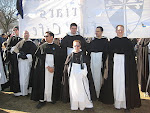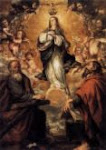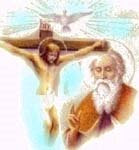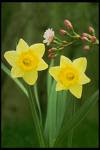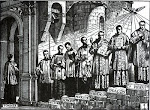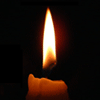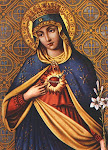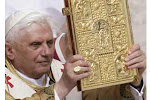(Llansantffraed- Llan-sant-ffraed: holy place of -saint-Bridget pron Thlan-sant-fried)
Ynysgynwraidd-Ynys-gyn-wraidd: Island of Cynffrath(pron -unuss-gun-fryth)








 _____________________________
_____________________________The Great Altar Tomb of John ap Philip Morgan 1557(Above)
Keeper of the Duchy of Lancaster(see the roses on the chevron) is buried in this tomb. He was the principal farmer of the Three Castles area.
SkenfrithYnys Cynfraeth
The Normans built three small castles in the North of Gwent-Grosmont, Skenfrith and Castle Gwyn, which people have translated as 'White Castle' although it was his name. The Normans had superior military strength but they needed to consolidate what they had in England and contented themselves in Gwent with erecting huge castles (following the Norman Conquest of 1066 and the Battle of Hastings)to keep out the Welsh.
White Castle was built by Gwyn ap Arthfoed-the castle was painted white too!
Grosmont was built by his brother Aethan ap Arthfoed
Skenfrith was built by Bach ap Arthfoed
Obviously all Welsh themselves and a clever move!
Monmouth had a castle
Abergavenny had a castle (de Braose)
Usk had a Castle
Chepstow was the first Castle to be built by William FitzOsbern, one of William the Conqueror's henchmen.
All these castles had either priory churches, or churches attached. Priests would come from the monastic orders initially and be sent for a certain period of time to nearby castles.
Skenfrith then is the Island of Cynfraeth, or island but could mean 'river meadow'.Skenfrith has a history of flooding. The castle there was built on 10 feet of gravel to take it up over the waterline, so maybe a local hill would have been an island during these floods.
Originally it was called Llantilio Castle - so there was definitely a Llan in that area dedicated to St Sulien(Tysilio). And there is also a Llantellen, and a Chapel/well dedicated to Noe (St Noye?).
In 1881 there were 440 inhabitants in this village. The twentieth century saw its inhabitants increased by 5. (Hando)
Location
Easily reached by bus from Ross on Wye. OR Monmouth and head north to Skenfrith.
A great trail is through Usk, Bettws Newydd, Llanarth, Llantilio Crossenny and White Castle'.You can park near the church, cross the meadow and dive into the deep, cold water fresh from the Black Mountains-at your own rist of course- but there is little better, This is the River Monnow from which Monmouth takes its name.
Skenfrith Castle
Good to visit. CADW. It is a Keep, raised on a square mound in the middle, not attached to anything else.. The dungeon underneath the keep is on a level with the Court.It had no stone built appartments and so it seems the garrison were in wooden buildings and huts.
The Church of St Bridget(Anglican Administration after 16th century)
Catholic Resistance, Recusancy and Penal Times- A Hotbed at Skenfrith!
This church is situated in a valley and I believe the Welsh name, from which Skenffrith has been anglicised is the :'Island of Cynfraeth , a sixth century chieftain. The church here is dedicated to St Bridget perhaps from even earlier Celtic times. The church would have also had a dedication to the Virgin Mary , to whom most churches have a dedication because of Mary being the Ikon of the Body of Christ ie the Church.(OS SO456203)is the location of the Church and (SO 462203)the location of St Bride's Well in nearby woods at Coed Angred.
Blessed St John Kemble
This area has a strong link to the Catholic resistance to the Penal laws inflicted on Catholics for almost three centuries, beginning with the late Tudors. Catholics would be baptised at St Bridget's well, buried in Coed Angren and hold secret Masses and rosaries whenever it could be managed. Here at Skenfrith and at Abergavenny runs an unbroken Catholic tradition, possible only because of the bravery and faith of the faithful, the bravery of the Jesuit priests of which four heroically died in cruel ways (largely at the behest of some landed families who had grown rich on obtaining Church property and were determined to crush the church which might threaten their right to it)and finally because of the simple goodness and generosity of local Protestants, laity and sometimes clergy moved by the distressing plight of a Welsh speaking community forced to accept something against their convictions.Many of the arrangements for these covert services and pilgrimages to lonely areas where a rosary might be said were arranged using the Welsh language, while local aristocracy were mainly English incomers and found intelligence difficult, as on the whole, the Welsh held together.
St John Kemble
The recently canonised Saint, John Kemble was a famous Catholic son of Skenfrith, and a shrine is maintained to his memory at the Catholic Church in Monmouth. In addition, Monmouth Catholics annually visit his grave in pilgrimage. It must have been wonderful to stand in St Peter's Basilica when his name, and that of the other martyred priests was read out back in the 1970s.Father John Lloyd, Father Philip Evans, Father David Lewis and Father John Kemble-the last two over 60 years of age were hung drawn and quartered, the first two in Cardiff, Father David at Usk and Father John in Herefordshire.I will write more about these later on. These were not dissident terrorists, they died because of the anxiety and lies spread by Titus Oates, that Catholic priests were plotting to overthrow the crown.When his lies were discovered Oates himself was executed, but so had 120 innocent Catholic priests. In many cases, threats and coercions, especially of women forced them to testify against the priests, but often people were bribed to perjure themselves to get a death sentence.More of this later.
The Woods and Catholic Chapel at Coed Angred
The Catholic chapel at Coedangred, dedicated to the Immaculate Conception, was erected in 1847, and has a cemetery attached.The Chapel was dedicated to The Immaculate Conception.It was fitting that a church was built here where so many faithful were furtively buried in those terrible times.St Bridget's Well would doubtless have been used for Baptisms and for the washing of the faithful departed before the burials. The ancient usages came back into being, just as at St Maughams and Rockfield, two ancient Welsh Llans turned into Norman Churches in the middle ages and which buried actually in the churchyard, the remains of two Catholic recusant priests, and several more at Rockfield, including Bishop Matthew Pritchard, Vicar Apostolic of the Western Region, who lived at the Catholic house at Perth-hir and who is buried beneath the altar in the now Anglican Church.Catholic monuments in graveyards often had IHS written on them, and where the local Lord of the Manor was a recusant Catholic, with the responsibility of appointing an Anglican priest to the living, they were more than happy to oblige.
Ffynnon Ffraeth-St Bridget's Well
The Well of St Bridget is nearby and this could possibly mean there was an earlier Llan development here in Celtic times, but it is so difficult to be sure in the sixth century. The cult of St Bridget was extremely popular all over England in the middle ages too. If anyone reading this can confirm this or put a gloss on this I would be grateful.There is a distant picture of the well on 'More ictures of Skenfrith Blog on Friday.
 _______________________________
_______________________________St Brigid's Well in Kildare
However it seems certain that the church was an Old Welsh dedication to an Irish Saint, which common to other developments (and the castle itself) seems to have been built on the pattern of a Saxon Hall with a central nave and side aisles, the earlier church may have been rebuilt in Old Welsh times in Stone,as well as at Llanhylleth, but certainly the earliest church on this site was consecrated to the Blessed Virgin (as were all monasteries and churches, in 1207, possibly served by the monks of the nearby Priory of Our Lady and St Florent in Monmouth or from Abergavenny.There is an ancient head of a nun over the porch which is said to represent Bridget.
The Church of St Bridget
The originally ancient Catholic Church of St Bridget stands next to the River Monnow (Afon Mynwy) close to the border with England. The tower dates from a time when the Welsh borders were often raided by the English and people would need to take refuge. The walls of the tower are five feet thick.The old yew tree by the gate is older than the present church, and as I said there were probably a series of churches, mud and wattles, wooden or otherwise. The dedication is definately from an earlier source.The guidebook, written by Emeritus Professor E.G.Bowen writes that the Normans were in Skenfrith by 1075 and had built a motte and bailey castle on the site soon afterwards.Further 'I doubt if these Marcher Lords, whatever the harshness of their lives, would have lived there for five generations from 1075-1200 or thereabouts without a church.This present church was built during the time of King John (1199-1216)and not from the time of William the Conqeror, or obviously the sixth century time of Bridget herself.The style was known as Gothic or Early English, although there are plain round pillars in the church reminiscent of Norman ideas.
Matthew de Hereford Priest in 1207-Transfer to Grace Dieu
In 1207 it is recorded that the "Priest of Skenfrith-Matthew de Hereford-paid ten marks to King John to sent letters to William de Braose (lord of Abergavenny) to permit him quietly to enjoy his church at SKENEFRID which he had of the gift of the King".(Professor Bowen)Then Henry III gave the rights of the church to Edward Cruxback who in 1291 transferred it to the Abbot of Grace Dieu, a Cistercian Abbey whic stood "in a wood twixt WISK (Wsg-Usk) and Rzglande (Raglan). Grace Dieu will be incuded in later blogs on the Cistercians. The remains of the Abbey still lie in a meadow there-unfortunately, it had been pouring with rain and I had no wellies so was not prepared to go yomping over the fields for photos-but I will go back prepared!'I did not find them between Usk and Raglan but south of Hendre nearer Monmouth. Henry VIII changed to his religion in the sixteenth century and seized the land and avowson of Skenfrith for his own new church.
Oliver Cromwell and General Fayrfax-17th century-Puritans
The new church itself had problems under Cromwell with Puritans installed. A'Lewis David' was deprived of it and 'Lewis Parry' put in his place.He probably busied himself with an inscription from Ecclesiastes ' Keep thy foot when thou goest to the house of God and be more ready to hear than to give the sacrifice of fools'. Quite an insult to the Lord in this context.
The Cecils of Duffryn had the church and advowson next and 1854,the church was sold about 1890 to Robert Newton Jackson of Blackbrook. In 1921, the Church in Wales was disestablished and so private patronage ceased.
The Altar is original
The stone altar is the original Catholic one and actually dates from 1207. It was thrown down and buried by Thomas Cromwell's agents, but was then buried in situ for a number of years, forming part of the floor. It was restored on its present new pillars only a few years ago. Since the penal times, the wooden table by the door was used instead. It would have been interesting to know which relic was buried in the original altar.
The East Window
This window has been leaded up with fragments from ancient glass collected from the churchyard (where it had no doubt been smashed) by a former vicar. The whole of the window glazing has been refixed with this 15th century glass, and releaded.
The Sanctuary Carving is very interesting representing five periods of the church in the form of fifteenth century 'bosses' altough they are French in design.


 _____________________________
_____________________________1)Acorns and Oakleaves representing St Bridget.
2) The Fleurs de lys-the Design was borne by the Prince of GWENT and later gave place to the three feathers of the Prince of Wales.
3)Single Rose of Lancaster -Lords of Skenfrith were Lancasters. Henry de Grosmont, first Lord of Grosmont Castle was born at Skenfrith.
4)Tudor Rose, Henry VII and his Wife, Elizabeth the Rose of York were bth descended from the Lords of Skenfrith.
5)The Pomegranite -from the Royal arms of Spain , possibly inrtroduced by Constantia,Princess of Spain and second wife of John of Gaunt , Duke of Lancaster and Lord of Skenfrith.
Piscina
This is the stone basin on the side of the altar . It was used to receive water in which the priest washed his hands before the Eucharist and the Chalice after the Mass. It dates from the middle of the thirteenth century and is semi circular even though it belongs toGothic times.
The Rood Screen
A portion of the rood screen is still to be seen here. Professor Bowen writes 'it is pierced in the form of tracery and one carving is in the form of a cross.On the right of the chancel arch are still to be seen the steps which lead to the rood loft.
The squints
The squints were almost like windows to allow the faithful to view the elevation of the Host during Mass.
The Stoup with Holy Water
 ____________________________
____________________________When you enter a Catholic Church, you take Holy Water (which is blessed in a special ancient ceremony using the Easter (Paschal Cantle) With it you make the sign of the Cross as you enter the church-Forehead, Heart, Left to Right shoulders. This is a special invocation to the Trinity for guidance. It is sanctifying-makes you remember your Baptism, when you died to the World and became a Christian. This stoup at Skenfrith is original and many earth Christians in Skenfrith would have used it.
The Minstrels' Pew
Can be seen, from the times before organs were used in church. The original position may have been above the arch leading to the present vestry.
St Bridget allusions
Acorns, oak leaves and flames can be seen in the sanctuary. I apologise for the bad quality of the picture of Bridget's sculpture on the lectern! I had problems and shall be trying to return to Skenfrith shortly to retake the photos. I think you can get a good idea of this and the Catholic cope.
Time Team-Channel 4
Last night I watched Time Team-a programme of 'fun archeology' on the Discovery Channel. To my delight it was from Llangorse in Brecon (the next county North of Monmouthshire. Llangorse is a most beautiful lake in the beautiful country of Wales. The found the site of two 'llans' there and an Irish settlement. Apparently many Irish uniquely settled in Wales in the sixth century. 8 Ogham inscribed stones have been found using the Irish Ogham alphabet and some in Brecon museum. Now if there was an Irish settlement, and perhaps even raiders had settled down and intermarried with native Welsh, it would account for the enormous popularity of St Bridget and the demand for her intercessory prayers. Bridget herself had come to Wales, but we are fortunate to have four churches dedicated to this Irish Saint.Llangorse is not in Gwent, but well known to Gwent people for day trips, boat trips and beautiful scenery. Cardiff University Archeology department are meant to be continuing the dig near Llangorse Church.
To leave the subject- and I will provide you with better photos(!) I am going back to 1951 and Fred Hando's final remark
'When is Skenfrith most beautiful? In Summer, Autumn, Winter? At Twilight or by Moonlight? To me it is most alluring on a May morning. The hillsides, soft in outline, veiled in silver, frame the lovely church ; fruit trees hold out to it the pearls and opels of their blossoms; the ancient yew breathes over it a Benediction; and the river sings its cheerful, young song as it flows towards the Mill"
The Pleasant Land of Gwent Fred Hando P79
More facts about Brigid
She received the nun’s veil from Bishop Macaile of Westmeath. Afterward, gathering a group of women around her, she founded a nunnery at Kildare (Church of the Oak). Needing to have the sacraments performed, Brigid prevailed upon Conlaed, the leader of a nearby group of anchorites, to receive episcopal consecration and to move with his followers to a site adjacent to the nunnery. This conhospitae “mixed house” based upon the Celtic social concept of equality between men and women was unique among Irish religious foundations. Brigid as abbess of Kildare influenced Irish church affairs and headed a network of nunneries as well. Kildare prospered under royal favour in the seventh century becoming one of the most magnificent churches in Ireland during this time. When Brigid died c.525, she was buried alongside Conlaed beneath the altar at Kildare. Three centuries later her body was translated to lie beside the remains of St. Patrick at Downpatrick, one of Ireland's most holy shrines. The shrine was despoiled during the Reformation and its relics dispersed.
Cogitosus writing c.650 wrote of her miracles.
Brides, Fertility and corn dollies
Later “lives” added to these miracle stories. Her childhood miracles were associated with the multiplication of food such as providing butter for the poor. This was also the speciality of the Druid deity and her special fertility reputation. The name ‘Bride’ also comes from ‘Bridget’ or briodhe.So our custom of calling an unmarried woman about to marry comes from the name (German ‘Braut’- and Welsh word for ‘marriage’ is ‘priodi’ or something like this). It is customary for brides to carry corn, wheat, corn dollies and in some places Bridget crosses or flowers or a mixture of these things. The British custom of the Father handing over his daughter in marriage comes from these earlier times, but has died out in many parts of Europe.
In addition, the Veil is a Christian addition signifying purity and chastity. The traditional crown of flowers has been changed for a tiara as more money becomes available. Fertility was important in all ancient societies, for animals and people and nature. In Southern Gwent , even today in mid January men in Chepstow, pour Beer on the apple trees to improve their yield.
As an abbess, with the assistance of angels, she caused cows to give milk three times the same day to enable visiting bishops to have enough to drink. Brigid was also credited with taming a wolf at the request of a local chieftain whose pet dog had been killed accidentally by a peasant.
Irish Monks in Wales
Brigid’s cult spread rapidly throughout Ireland, and as Irish monks wandered throughout England, Wales, and the Continent, they carried Brigid’s cult into those areas as well. In England at least ninenteen churches were dedicated to her, most notably St. Bride's Church on Fleet Street in London.
Feast Day February 1st and the St Brigid Cross
A special plaited cross twisted from rushes was made by Brigid. She is often shown on an icon with a cow lying at her feet. Brigid’s feast day is February 1,(which is also the sacred before Christianity , as Imbolc, the Celtic festival of Spring.As a Druid deity, she was also a deity interested in fertility and plenty.
Gerald the Welshman 1186, just before the tour of his native Wales
Brigid is still venerated in Alsace, Belgium, and Portugal. Writing in the late twelfth century, Gerald of Wales noted a feature of her cult he witnessed on a visit to Kildare in 1186. There, a sacred fire maintained daily by twenty nuns (nineteen, after Brigid's death) burned continuously. The walls of the firehouse remained on the hill by the abbey church until the eighteenth century. Today, only the foundations remain, as a result of political problems
Mary of the Gael
As one of Ireland’s most beloved saints, Brigid is known as the “Mary of the Gael.” She is most noted for her compassion to others, especially to victims of violence, the impoverished, and lepers. Once she gave her father’s sword to a leper. Her father, who did not know of her act of charity, became furious and could not control this daughter who gave away his wealth and possessions as commanded by the Way of Christ.
The Castle






